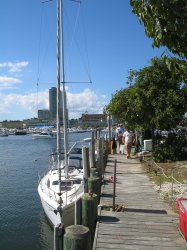
Student
Robert Walker
Lancaster, PA, USA
More User info
Skipper Large Sailboat Level III
Status: Sailor
Qualified days: 65
Posted 2015, Oct 29 16:31
in 2.4.1 you state: "The higher the electrical voltage the more powerful is the current output. Every sailor who uses electricity for any purpose is well advised to know what the voltage is, whether it is AC or DC. Volts can burn, maim or kill if improperly handled."
this is not precisely true. static from walking across a carpeted floor in a dry house can create a spark of 1000V. The current, however, is minuscule. THe 12V boat battery can seriously hurt you because of the high current available. More clarity in this section would be appreciated.

Student
Robert Walker
Lancaster, PA, USA
More User info
Skipper Large Sailboat Level III
Status: Sailor
Qualified days: 65
Posted 2015, Oct 29 16:34
I would love to see you include a section on Electric Shock Drowning (ESD). Primarily a problem in fresh water, some of the class may be fresh water sailors and it can be a problem in the low salinity brackish waters of bays and rivers as well. There are many good articles on this available, even posting a link to one would be a good step in ensuring the safety of boaters.

Student
William Denyer
Miami, FL, USA
More User info
Crew Level 0
Status: Sailor
Qualified days: 0
Posted 2017, Jun 06 23:39
1. What is the minimum engine RPM recommended for charging the batteries?
2. Should the RPM be set while underway with the engine in gear or is it equally acceptable to set the RPM with the engine in neutral?
3. How long must the engine be run to fully charge batteries that are significantly depleted (11.0 volts)?

Student
William Denyer
Miami, FL, USA
More User info
Crew Level 0
Status: Sailor
Qualified days: 0
Posted 2017, Jun 06 23:44
What is the minimum acceptable battery voltage before taking steps to recharge them?

Student
Wilfred Darr
Calgary, Canada
More User info
Skipper Large Sailboat Level II
Status: Big Time Sailor
Qualified days: 28
Posted 2017, Oct 03 01:21
Further along in the course it is stated "It is prudent to always assign one “isolated” battery or a bank of batteries for the sole purpose of starting the engine. Never use it for other tasks." This means at some point you must switch from the engine battery to the house batteries with the engine running. However, in the picture of the battery switches, there is a notice that reads
"Important: wait for engine to come to a full stop before turning batteries off".
I have to assume then that this does not mean "do not turn individual batteries off while the engine is running", but rather "never turn both batteries off at the same time"?
Assuming that I'm correct in my above assumption, what is the proper procedure after start (after giving a couple of minutes for the engine battery to recharge after starting) to switch the house batteries back on and disconnect the engine battery?
Say 1 is Engine and 2 is house I'm assuming
1 -> Both -> 2
and never
1 -> BOTH OFF -> 2
Is my understanding of this topic correct?
Is there any difference operationally between how one would use that displayed in the picture and a 4 way switch, especially since there is no common present with a 4 way switch mounted?
Thanks

Student
Bill Wolfson
Flemington, NJ, USA
More User info
Skipper (small keelboat) Level II
Status: Big Time Sailor
Qualified days: 31
Posted 2018, May 06 12:10
The text references NMEA 0180. I have not seen this before. Is this an earlier version of NMEA 0183 and NMEA 2000?

Student
Paul Mallon
Guilderland, NY, USA
More User info
Crew Level 0
Status: Sailor
Qualified days: 0
Posted 2019, Jan 27 17:42
I have experienced that the AC plugs on boats do not work when motor sailing, and an inverter is still needed. If the engine is on, doesn't the alternator generate AC?

Student
Robert Johnson
Albuquerque, NM, USA
More User info
Skipper Large Sailboat Level III
Status: Sailor
Qualified days: 85
Posted 2021, Mar 10 19:27
Since 1984, the standard mains voltage in the US has been 120 VAC or 240 VAC, plus or minus 5 percent, not 110 VAC and 220 VAC, as stated in this module. So, for a typical outlet, the voltage could be from 114 to 126 VAC. If one were to measure 110 VAC at an outlet in the US, this could indicate faulty wiring or some other issue that could pose a danger.

Student
Trevor Smith
Houston, TX, USA
More User info
Qualified Crew Member Level III
Status: Sailor
Qualified days: 68
Posted 2021, Jun 25 22:17
The diagram shows the battery - & + terminals are always directly connected to the bilge pump so it will always operate - providing the float switch is activated. Opening and closing the switch at the breaker panel will have no effect on stopping or starting the bilge pump. If the intention is to allow the pump to be switched off/isolated at the panel, then one solution would be to run a (red) line from the + terminal of the battery to the manual switch and then from the other terminal of the switch to the float switch.
![avatar]()
Student
Kelly Leahy
Kirkland, WA, USA
More User info
Bareboat Charter Master Level IV
Status: Big Time Sailor
Qualified days: 134
Posted 2022, May 16 22:58
Since you mention that there is a DC battery charge controller in this picture (to control overcharging of the batteries) it might be worth mentioning that there is (or had better be) a similar controller for permanently mounted solar panels too, as they too have the ability to overcharge a battery (assuming the solar panels produce more energy than your load on the battery drains).